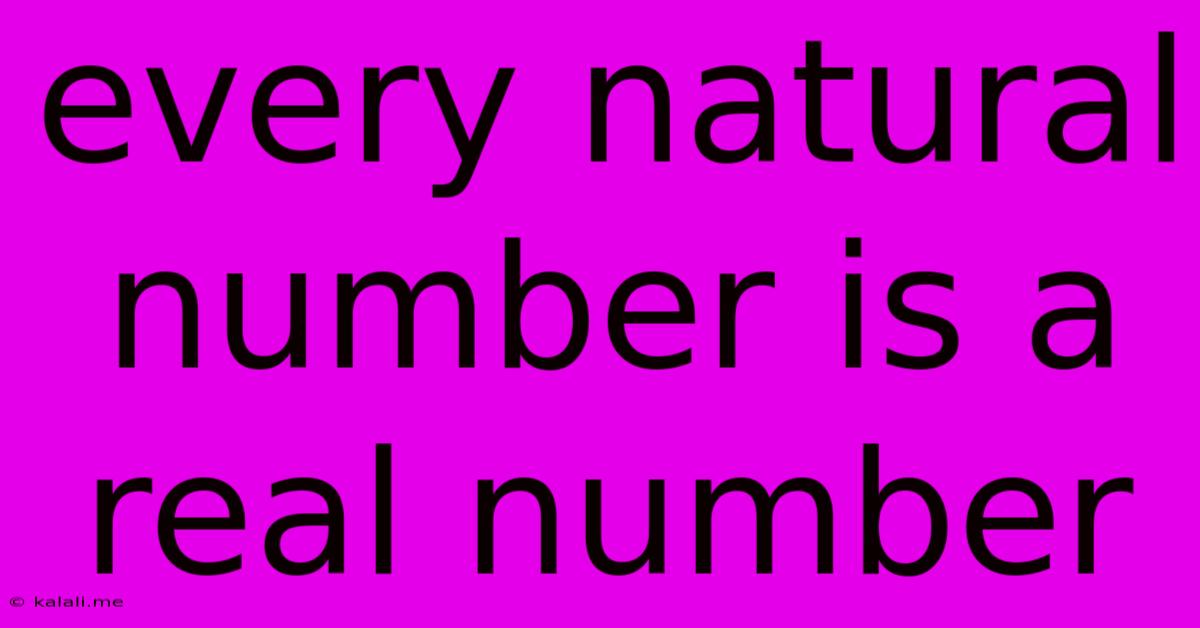Every Natural Number Is A Real Number
Kalali
Jun 14, 2025 · 3 min read

Table of Contents
Every Natural Number is a Real Number: A Mathematical Proof and Exploration
Meta Description: This article explores the relationship between natural numbers and real numbers, providing a clear explanation and mathematical proof demonstrating that every natural number is indeed a real number. We'll delve into the number systems and their properties.
The statement "every natural number is a real number" is a fundamental truth in mathematics. Understanding why this is true requires a brief look at the different number systems and their hierarchical relationships. This article will provide a clear and concise explanation, supported by mathematical reasoning.
Understanding Number Systems
Before diving into the proof, let's establish a clear understanding of the number systems involved:
-
Natural Numbers (ℕ): These are the counting numbers: 1, 2, 3, 4, and so on. They are positive integers and form the basis for many mathematical concepts.
-
Integers (ℤ): This set includes natural numbers, zero (0), and the negative counterparts of natural numbers (-1, -2, -3, etc.).
-
Rational Numbers (ℚ): These are numbers that can be expressed as a fraction p/q, where p and q are integers, and q is not zero. This includes all integers (since any integer can be written as itself divided by 1) and many other numbers like 1/2, 3/4, -2/5, etc.
-
Real Numbers (ℝ): This is the broadest set we'll consider here. Real numbers encompass all rational numbers and irrational numbers. Irrational numbers are numbers that cannot be expressed as a simple fraction, such as π (pi) and √2 (the square root of 2).
The Proof: Why Every Natural Number is a Real Number
The relationship between natural numbers and real numbers is one of inclusion. Every natural number is contained within the set of real numbers. We can demonstrate this through the following reasoning:
-
Natural numbers are integers: Every natural number is also an integer. This is self-evident; the natural numbers are a subset of the integers.
-
Integers are rational numbers: Every integer can be expressed as a fraction with a denominator of 1 (e.g., 5 = 5/1). Therefore, all integers are rational numbers.
-
Rational numbers are real numbers: All rational numbers are included within the set of real numbers.
-
Therefore, natural numbers are real numbers: Since natural numbers are integers, which are rational numbers, which are real numbers, it follows logically that every natural number is a real number.
Visualizing the Relationship
Imagine a series of nested sets:
- ℕ ⊂ ℤ ⊂ ℚ ⊂ ℝ
This notation signifies that the natural numbers (ℕ) are a subset of the integers (ℤ), which are a subset of the rational numbers (ℚ), which are in turn a subset of the real numbers (ℝ). This visual representation clearly shows the hierarchical inclusion of natural numbers within the broader set of real numbers.
Implications and Further Exploration
The understanding that every natural number is a real number is crucial for many advanced mathematical concepts. It lays the foundation for working with more complex number systems and their properties. Further exploration could involve examining the properties of different number systems, exploring the concept of completeness in real numbers, and delving into the intricacies of irrational numbers. This fundamental relationship simplifies many mathematical operations and proofs. It allows us to treat natural numbers within the broader context of real numbers without loss of generality.
Latest Posts
Latest Posts
-
Example Of Solid Dissolved In Solid
Jun 14, 2025
-
Air Pressure At Sea Level Is Equal To
Jun 14, 2025
-
What Is The Opposite Of Reluctant
Jun 14, 2025
-
Brass Is A Mixture Of What
Jun 14, 2025
-
Which Of The Following Are Pure Substances
Jun 14, 2025
Related Post
Thank you for visiting our website which covers about Every Natural Number Is A Real Number . We hope the information provided has been useful to you. Feel free to contact us if you have any questions or need further assistance. See you next time and don't miss to bookmark.